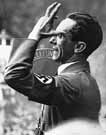
|
|
|

|

|

|

|
|
Click on an image to see a larger, more detailed picture.
|
|
|
|
|
| 1941: Mass Murder |

|
pg. 260 |

|
|
|
|
| |
 Following their occupation of Latvia, Germans and Latvian Fascists moved quickly against the nation's Jews. In Riga, synagogues were destroyed and Jews were beaten, raped, and shot. First marginalized within Latvian society, Jews were then excluded from it in August when they were ordered into the Riga Ghetto. Here, Jewish men and women are forced to perform the most menial and backbreaking labor: clearing the rubble from a street near a Catholic church.
Following their occupation of Latvia, Germans and Latvian Fascists moved quickly against the nation's Jews. In Riga, synagogues were destroyed and Jews were beaten, raped, and shot. First marginalized within Latvian society, Jews were then excluded from it in August when they were ordered into the Riga Ghetto. Here, Jewish men and women are forced to perform the most menial and backbreaking labor: clearing the rubble from a street near a Catholic church.
Photo: Bundesarchiv / United States Holocaust Memorial Museum Photo Archive
|
 Rallying the German nation to war against the Soviet Union, Minister of Propaganda Joseph Goebbels could reach most of the populace through his radio broadcasts by the end of 1941. War on two fronts did not deter Goebbels from pressing for the removal of Jews from German society. The first deportation of Jews from Berlin occurred in October.
Rallying the German nation to war against the Soviet Union, Minister of Propaganda Joseph Goebbels could reach most of the populace through his radio broadcasts by the end of 1941. War on two fronts did not deter Goebbels from pressing for the removal of Jews from German society. The first deportation of Jews from Berlin occurred in October.
Photo: AP/Wide World
|
 Killing Accomplices
Killing Accomplices
During their tireless campaign to annihilate Europe's Jews, the Nazis found thousands of willing accomplices among the populations of Eastern and Western Europe. Indigenous police forces in France and the Netherlands took part in roundups. Hungarian troops and Fascist extremists joined the hunt and helped slaughter thousands. Slovakia's Hlinka Guard, modeled on Nazi Storm Troopers, attacked Jews while local police organized deportations. The Ustasa --a Croatian nationalist, separatist, terrorist organization--tortured and barbarously murdered Jews with axes and hammers. In Romania and the Crimea, the bloodthirsty enthusiasm of volunteer ethnic Germans and Romanian army units who engaged in mass shootings shocked even the SS. When the mobile killing squads of the Einsatzgruppen swept into the Soviet Union, their comparatively thin ranks were augmented by auxiliary troops of native Estonians, Latvians, Lithuanians, and Ukrainians. The Omakaitse, Estonian police collaborators, rounded up the Jews of Tallinn and helped the Nazis shoot hundreds. Selbstschutz, Latvian police, assisted in the killing of thousands in Riga. Lithuanian police seized and executed Jews, while Lithuanian nationalists killed thousands in pogroms. The particularly brutal Hilfspolizei (Ukrainian Auxiliary Police) hunted down Jews escaping from ghettos and killed thousands. Without the work of these sympathizers, the Nazi campaign of genocide would have been noticeably less effective.
Photo: Romania Library of the Academy/United States Holocaust Memorial Museum Photo Archive
|
|

|

|

|

|
 September 1941: The Germans open an exposition in Paris called "The Jew and France." Visitors see sculptures and paintings of hideous mythical Jews, Jews allegedly cursed to wander the world forever because of their supposed attack on Jesus Christ, and Jews allegedly out to control the world. Other exhibits portray the Jew as a repulsive monster destroying France. In the first few days, more than 100,000 Parisians visit the exhibit.
September 1941: The Germans open an exposition in Paris called "The Jew and France." Visitors see sculptures and paintings of hideous mythical Jews, Jews allegedly cursed to wander the world forever because of their supposed attack on Jesus Christ, and Jews allegedly out to control the world. Other exhibits portray the Jew as a repulsive monster destroying France. In the first few days, more than 100,000 Parisians visit the exhibit.
|
 September 1941: Romanians and Germans force nearly 150,000 Jews into death marches to internment camps in Bessarabia, Ukraine. Many die of beatings, random shootings, fatigue, hunger, thirst, exposure, and disease.
September 1941: Romanians and Germans force nearly 150,000 Jews into death marches to internment camps in Bessarabia, Ukraine. Many die of beatings, random shootings, fatigue, hunger, thirst, exposure, and disease.
|
|
|
|
|
| 1941: Mass Murder |

|
pg. 260 |

|
|
The Holocaust Chronicle
© 2009 Publications International, Ltd.
|
|
